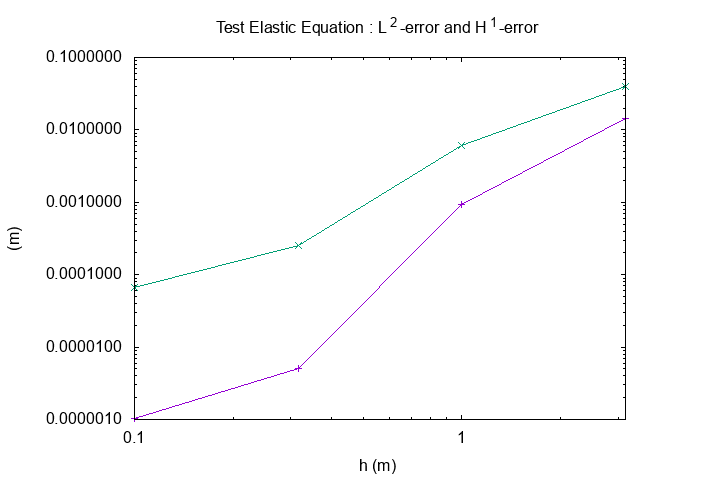Test Case of Static Elasticity in Cartesian Coordinates
1. Introduction
This page present a test case to validate the implementation of elastic equation with Hooke law without thermal dilatation in static and cartesian case in vectorial form.
The result permit, or not, to verify if our method for static elasticity resolution is good.
We inject a function, here \(\mathbf{u} = \begin{pmatrix} 0 \\ cos(2\pi \frac{x}{L}) \\ 0 \end{pmatrix}\), we inject in equation (Static Elasticity), we recuperate the associated coefficient. We run a simulation with those coefficient and compare the numeric result with the begining function.
2. Run the calculation
The command line to run this case is :
mpirun -np 16 feelpp_toolbox_coefficientformpdes --config-file=elastic.cfg
3. Data Files
The case data files are available in Github here :
-
CFG file - Edit the file
-
JSON file - Edit the file
-
GEO file - Edit the file
-
SH file - Edit the file : it serves to compute the same test case but with different mesh sizes.
4. Equation
We solve the elastic equation with Hooke law in static and cartesian case (for more detail see section In General Case).
The differential formulation is :
With :
-
Lamé’s coefficients : \( \lambda = \frac{E \, \nu}{(1-2 v) \, (1+\nu)}\) and \(\mu = \frac{E}{2 \, (1+\nu)} \) with :
-
Young modulus \(E\)
-
Poisson’s coefficient \(\nu\)
-
-
Displacement \(\mathbf{u} = \begin{pmatrix} u_x \\ u_y \\ u_z \end{pmatrix}\)
-
tensor of small deformations : \(\bar{\bar{\epsilon}}_{ij} = \frac{1}{2} \left( \nabla \mathbf{u} + \nabla \mathbf{u}^T \right)\)
-
Stress Tensor : \(\bar{\bar{\sigma}} = \lambda \, Tr(\bar{\bar{\epsilon}}) \, Id + 2 \, \mu \, \bar{\bar{\epsilon}}\)
-
Stiffness tensor : \(k\)
-
Volumic Forces : \(\mathbf{F}\)
And notations :
-
Divergence of tensor : \(\nabla \cdot \bar{\bar{\sigma}} = \begin{pmatrix} \nabla \cdot \bar{\bar{\sigma}}_{x,:} \\ \nabla \cdot \bar{\bar{\sigma}}_{y,:} \\ \nabla \cdot \bar{\bar{\sigma}}_{z,:} \end{pmatrix} = \begin{pmatrix} \frac{\partial \bar{\bar{\sigma}}_{xx}}{\partial x} + \frac{\partial \bar{\bar{\sigma}}_{xy}}{\partial y} + \frac{\partial \bar{\bar{\sigma}}_{xz}}{\partial z} \\ \frac{\partial \bar{\bar{\sigma}}_{yx}}{\partial x} + \frac{\partial \bar{\bar{\sigma}}_{yy}}{\partial y} + \frac{\partial \bar{\bar{\sigma}}_{yz}}{\partial z} \\ \frac{\partial \bar{\bar{\sigma}}_{zx}}{\partial x} + \frac{\partial \bar{\bar{\sigma}}_{zy}}{\partial y} + \frac{\partial \bar{\bar{\sigma}}_{zz}}{\partial z} \end{pmatrix}\)
-
Scalar produce of tensor : \(\bar{\bar{\sigma}} \cdot \mathbf{n} = \begin{pmatrix} \bar{\bar{\sigma}}_{x,:} \cdot \mathbf{n} \\ \bar{\bar{\sigma}}_{y,:} \cdot \mathbf{n} \\ \bar{\bar{\sigma}}_{z,:} \cdot \mathbf{n} \end{pmatrix} = \begin{pmatrix} \bar{\bar{\sigma}}_{xx} \, n_x + \bar{\bar{\sigma}}_{xy} \, n_y + \bar{\bar{\sigma}}_{xz} \, n_z \\ \bar{\bar{\sigma}}_{yx} \, n_x + \bar{\bar{\sigma}}_{yy} \, n_y + \bar{\bar{\sigma}}_{yz} \, n_z \\ \bar{\bar{\sigma}}_{zx} \, n_x + \bar{\bar{\sigma}}_{zy} \, n_y + \bar{\bar{\sigma}}_{zz} \, n_z \end{pmatrix}\)
5. Geometry
The geometry is a beam.
The geometrical domains are :
-
Omega: the beam-
Left: left surface -
Right: right surface -
Front: front surface -
Upper: upper surface -
Backward: backward surface -
Bottom: bottom surface
-
Symbol |
Description |
value |
unit |
\(L\) |
length of beam |
\(10\) |
m |
\(w\) |
width and height of beam |
\(0.3\) |
m |
We have \(\Gamma_{D \hspace{0.05cm} elas} = \texttt{Upper} + \texttt{Bottom} + \texttt{Front} + \texttt{Backward}\) and \(\Gamma_{N \hspace{0.05cm} elas} = \texttt{Right} + \texttt{Left}\)
6. Boundary Conditions
We impose the boundary conditions :
-
Strong Dirichlet on
Upper,Bottom,FrontandBackward: \(\mathbf{u} = \begin{pmatrix} 0 \\ cos(2\pi \frac{x}{L}) \\ 0 \end{pmatrix}\) -
Neumann on
RightandLeft: \( \bar{\bar{\sigma}} \cdot \mathbf{n} = 0 \)
On JSON file, the boundary conditions are writed :
"BoundaryConditions":
{
"elastic":
{
"Dirichlet":
{
"Upper":
{
"expr":"{0,cos(2*pi*x/L),0}:x:L"
},
"Bottom":
{
"expr":"{0,cos(2*pi*x/L),0}:x:L"
},
"Front":
{
"expr":"{0,cos(2*pi*x/L),0}:x:L"
},
"Backward":
{
"expr":"{0,cos(2*pi*x/L),0}:x:L"
}
},
"Neumann":
{
"Right":
{
"expr":0
},
"Left":
{
"expr":0
}
}
}
}
7. Weak Formulation
We obtain :
8. Solution
We take a function \(u = \begin{pmatrix} \frac{e^z}{r} \\ \frac{e^z}{r} \end{pmatrix}\). For Robin condition we put \(k=\begin{pmatrix} \mu & 0 \\ 0 & \mu \end{pmatrix}\). We inject that on (Static Elasticity) and we obtain :
9. Parameters
The parameters of problem are :
Symbol |
Description |
Value |
Unit |
\(E\) |
Young modulus |
\(2.1e-6\) |
\(Pa\) |
\(v\) |
Poisson’s coefficient |
\(0.33\) |
\(dimensionless\) |
\(\lambda\) |
Lamé’s coefficient |
\(\frac{E \, v}{(1-2 v) \, (1+v)}\) |
\(Pa\) |
\(\mu\) |
Lamé’s coefficient |
\(\frac{E}{2 \, (1+v)}\) |
\(Pa\) |
\(F = \begin{pmatrix} F_r \\ F_z \end{pmatrix}\) |
term source |
\(\begin{pmatrix} 0 \\ \left( \frac{2\pi}{L} \right)^2 \mu cos(2\pi \frac{x}{L}) \\ 0 \end{pmatrix}\) |
\(N / m^3\) |
On JSON file, the parmeters are writed :
"Parameters": {
"E": 1e6,
"nu": 0.3,
"mu": "E/(2*(1+nu)):E:nu",
"lambda":"E*nu/((1+nu)*(1-2*nu)):E:nu",
"L":10,
"Fx":"0",
"Fy":"(2*pi/L)*(2*pi/L)*mu*cos(2*pi*x/L):L:x:mu:lambda",
"Fz":"0"
}
10. Coefficient Form PDEs
We use the application Coefficient Form PDEs. The coefficients associate to Weak Formulation are :
Coefficient |
Description |
Expression |
\(c\) |
diffusion coefficient |
\(\mu\) |
\(\gamma\) |
conservative flux source term |
\(\begin{pmatrix} - \lambda \nabla \cdot \mathbf{u} - \mu \frac{\partial u_x}{\partial x} & - \mu \left( \frac{\partial u_y}{\partial x} + \frac{\partial u_x}{\partial y} \right) & - \mu \left( \frac{\partial u_z}{\partial x} + \frac{\partial u_x}{\partial z} \right) \\ - \mu \left( \frac{\partial u_y}{\partial x} + \frac{\partial u_x}{\partial y} \right) & - \lambda \nabla \cdot \mathbf{u} - \mu \frac{\partial u_y}{\partial y} & - \mu \left( \frac{\partial u_z}{\partial x} + \frac{\partial u_x}{\partial z} \right) \\ - \mu \left( \frac{\partial u_z}{\partial x} + \frac{\partial u_x}{\partial z} \right) & - \mu \left( \frac{\partial u_z}{\partial y} + \frac{\partial u_y}{\partial z} \right) & - \lambda \nabla \cdot \mathbf{u} - \mu \frac{\partial u_z}{\partial z} \end{pmatrix}\) |
\(f\) |
source term |
\(\begin{pmatrix} F_x \\ F_y \\ F_z \end{pmatrix}\) |
On JSON file, the coefficients are writed :
"Materials":
{
"Omega":
{
"elastic_c": "mu:mu",
"elastic_gamma":"{-lambda*(elastic_div_u) - mu*elastic_grad_u_00,-mu*elastic_grad_u_10,-mu*elastic_grad_u_20, -mu*elastic_grad_u_01,-lambda*(elastic_div_u) - mu*elastic_grad_u_11,-mu*elastic_grad_u_21, -mu*elastic_grad_u_02,-mu*elastic_grad_u_12,-lambda*(elastic_div_u) - mu*elastic_grad_u_22}:lambda:mu:elastic_div_u:elastic_grad_u_00:elastic_grad_u_01:elastic_grad_u_10:elastic_grad_u_11:elastic_grad_u_20:elastic_grad_u_21:elastic_grad_u_22:elastic_grad_u_02:elastic_grad_u_12",
"elastic_f": "{Fx,Fy,Fz}:Fx:Fy:Fz"
}
}
11. Validation
We compute the L2-error between numerical solution and begining function with different size of mesh :

\(L^2-error\)
|
The method converge with polynomial order, the L2-error form a right in xy logarithmic scale.
Conclusion : We trust on this method to solve the static elasticity equation (Static Elasticity).